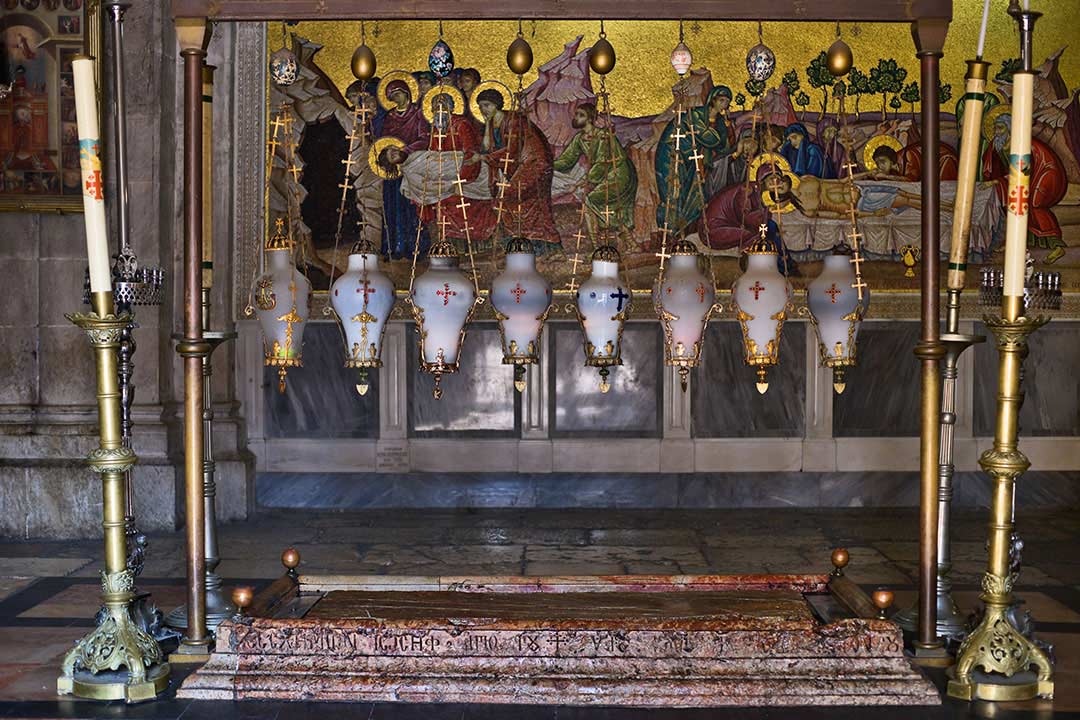
The greatest pilgrimage of all – that of Our Lord on His way to the Cross – took place in and around the modern city of Jerusalem. The steps He took for our salvation nearly 2000 years ago can be retraced even today. The sites He made holy are surrounded by celebration and throughout the year, but especially during Holy Week, when the Universal Church more commemorates this salvific act.
Holy Week in the Holy Land begins on Palm Sunday with two processions, one during Mass in the Holy Sepulcher, with pilgrims and locals participating through the waving of palm branches and singing songs of joy. The second procession begins on the Mount of Olives near the biblical site of Bethany. It draws hundreds of faithful, who sing, pray, walk, and dance, as they follow the way of Our Lord’s triumphal entry into Jerusalem.
Pilgrims blessed to be able to travel to the Holy Land during this sacred week can take part in other traditions unique to these sites, such as the veneration of the Flagellation Column, where our Lord was whipped for our transgressions, which takes place on the Wednesday of Holy Week. To add to the solemnity of the time, traditional pilgrimage activity is often halted during the Triduum.
After Our Lord shared the Passover meal with His Apostles and gave us the great gift of the Eucharist, He continued the pilgrimage of His Passion by singing and praying His way to the Garden at Gethsemane. Modern pilgrims retrace these steps through a formal pilgrimage to the site of the Upper Room that continues to the Basilica of All Nations in the Garden. There, around the Rock of Agony where Our Lord asked His disciples to watch and pray, a Holy Hour occurs, followed by more private prayer in silence until midnight.
To honor and remember the forced pilgrimage of Jesus to the House of Caiphas following His arrest, pilgrims leave the Basilica and form a torchlight procession across the Kidron Valley to the Church of St. Peter in Gallicantu (where the cock crows). Early the next morning, even before dawn, pilgrims line up to be admitted into the Holy Sepulcher for the Good Friday liturgy, which lasts nearly three hours. Later that day, the commemoration of the death of Our Lord continues with many pilgrimages along the Way of the Cross, or Via Dolorosa. Group after group walks from one station to the next, praying and contemplating Jesus’ own journey to the cross.
The pilgrimage of Jesus from this life to the next did not end merely with his death on the Cross. His sacred body was lowered from the Cross into His mother’s arms and then lovingly anointed before being placed in His tomb. These events are replicated today in the Holy Sepulcher, atop the hill of Calvary, where the body of Christ is removed from the crucifix and carried down to the Stone of Anointing, where it is anointed with oils and perfumes. The body is then reverently carried to the central tomb where Scripture passages of the burial of Christ are proclaimed.
Pilgrims leave this somber occasion with solemn but joyful anticipation, knowing the tomb could not contain Our Lord. They are aware of the hope of His second coming, and know the next time they visit, the tomb will be empty once more, in celebration of His Resurrection. Jesus’ pilgrimage for our salvation continued beyond the grave into the depths of hell and then out of the tomb into eternal life!

